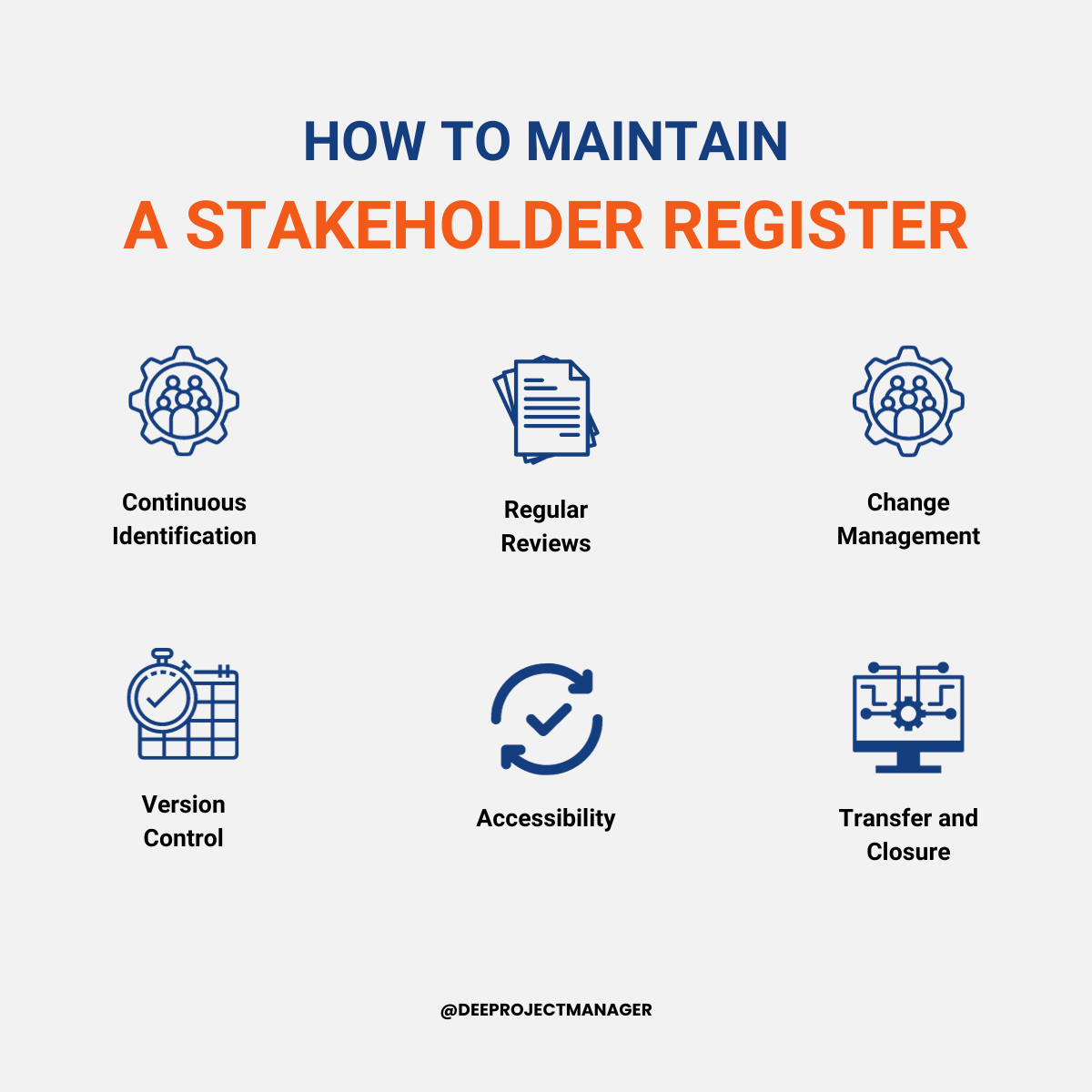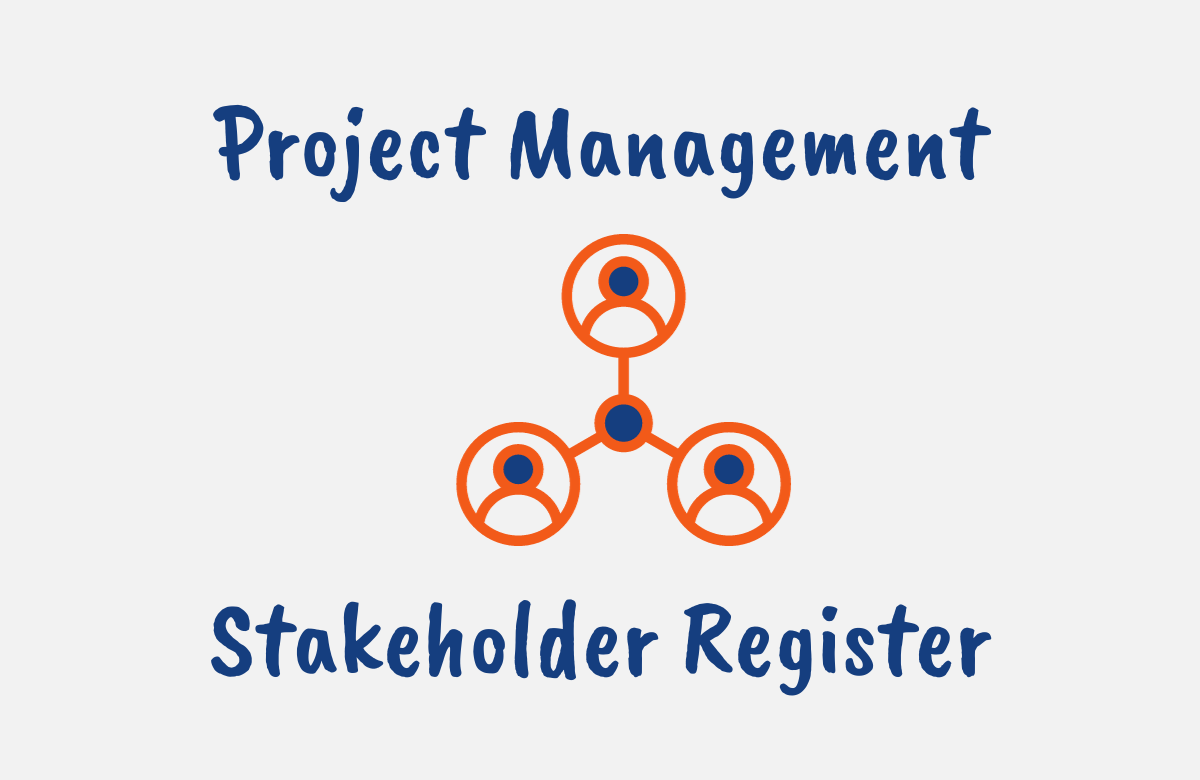When managing projects, it is important that you not only identify the stakeholders but also document and track them consistently. This is where a stakeholder register comes in handy.
By developing and maintaining a robust stakeholder register, you can identify all relevant stakeholders, document their interests and influence on the project, and determine optimal engagement strategies.
This centralized repository consolidates key data about your stakeholders in one place, providing valuable insights into managing these relationships for project success.
In this article, we’ll cover what a stakeholder register in project management is all about, and how to create and maintain one.
We’ll also provide a free stakeholder template that you can use to support effective stakeholder and communication management approaches on your projects.
What is a Stakeholder Register in Project Management?
A stakeholder register is a document used to capture all of the key information about the different stakeholders involved in a project.
Stakeholders in project management refer to any individual, group, or organization that can impact, be impacted by, or perceive itself to be impacted by the project.
The key elements a stakeholder register may contain include:
- Stakeholder names, roles, contact details
- Type of stakeholder (internal, external, primary, secondary)
- Stakeholder interests, requirements, expectations
- Stakeholder influence, power, and impact on the project
- Communication needs, preferences, frequency
Maintaining this centralized stakeholder information repository helps provide important visibility into the key stakeholders so you can analyze, categorize, and develop targeted engagement and communication plans tailored to their needs and interests.
Also, referring to your stakeholder register throughout the project lifecycle enables you to manage stakeholder relationships effectively.

The Purpose of the Stakeholder Register
Keeping a centralized repository of prioritized stakeholder data in the form of a stakeholder register is invaluable for managing relationships and aligning project work to stakeholder needs.
This stakeholder register serves several important purposes including:
Central Repository for Stakeholder Data
The stakeholder register acts as a centralized repository that consolidates all relevant stakeholder information in one place, including details like their influence on the project, interests, requirements, expectations, and communication preferences.
By having all this data in one document, it becomes easy to reference.
Stakeholder Analysis and Strategy
The data captured in the stakeholder register provides the foundation for stakeholder analysis activities.
You can categorize and prioritize stakeholders based on power, interest, etc., and develop tailored engagement strategies matched to their needs.
Communication Planning
The communication needs that are documented in the stakeholder register directly inform the communications management plan.
By using this data, you can define communication modes, frequency, and content appropriate for each stakeholder.
Stakeholder Tracking
The register enables tracking of stakeholders throughout the project lifecycle. As new stakeholders emerge and existing ones change, you can update the register to keep it current.
Stakeholder Management Continuity
If project team members change, the stakeholder register acts as a knowledge transfer tool to provide an understanding of relationships and engagement strategies for new team members.
What is Included in a Stakeholder Register?
The stakeholder register contains all the key information required to understand and manage your project stakeholders.
Capturing this well-rounded stakeholder data provides critical inputs to guide your stakeholder and communications management approaches.
While the specific data fields may vary, some typical contents include:
- Stakeholder names and contact details like phone, email
- Stakeholder roles and responsibilities
- Stakeholder type (internal or external)
- Stakeholder interests and concerns related to the project
- Influence and impact each stakeholder has on the project
- Requirements and expectations of each stakeholder
- Desired communication frequency, mode, and content
- Assessment of support or resistance to the project
- Strategies for engaging and managing each stakeholder

How to Create a Stakeholder Register
Creating a useful stakeholder register entails a systematic approach:
- Identify Stakeholders: Brainstorm and research to compile a list of all potential stakeholders. Engage experts and review other documents to ensure less visible stakeholders are included.
- Gather Stakeholder Data: For each stakeholder, gather details like influence, interests, requirements, and communication preferences. Then prioritize them based on their role and impact.
- Categorize Stakeholders: Assign categories like internal/external to inform engagement strategies.
- Define Engagement Plans: Outline optimal engagement approaches per stakeholder or group based on priority and category.
- Record in Register Template: Populate the stakeholder register template with all stakeholder data for easy reference.
- Continuously Update: Refine and update the register as stakeholders change through the project lifecycle.
Stakeholder Register Example
Below is an example of a stakeholder register for a CRM System Implementation project.
| ID | Stakeholder Name | Role | Type | Interest | Influence | Requirements | Communication Preference | Contact Details |
| 1 | Olsi | Client | External | High | High | Seamless data migration | Email, Monthly updates | olsi@gmail.com |
| 2 | Tuyota | Project Sponsor | Internal | High | High | Change management plan | Email, Monthly Sponsor Updates | tuyota@yahoo.com |
| 3 | David | Project Manager | Internal | High | High | Business case | Email, Weekly Project Meetings | david@gmail.com |
| 4 | Sameer | Lead Developer | Internal | Medium | Low | Payment terms | Email, Phone | sameer@gmail.com |
| 5 | Isabel | QA Analyst | Internal | Medium | Low | Quality requirements | Email, Phone | isabel@yahoo.com |
Stakeholder Register Template Excel
When starting a new project, you don’t need to reinvent the wheel to create a stakeholder register.
Organizations have templates, and once you identify your stakeholders, you update the template.
You can download a free stakeholder register below:

How to Maintain a Stakeholder Register
Consistently maintaining the accuracy and accessibility of the stakeholder register is vital for continued stakeholder management effectiveness.
Useful tips to effectively maintain the stakeholder register include:
1. Continuous Identification
Actively identify new stakeholders throughout the project lifecycle using engagement and risk management processes and adjust your engagement strategies accordingly.
2. Regular Reviews
Set calendar reminders to review the accuracy of the register regularly. Validate that interests, influence, requirements, etc. are still current.
3. Change Management
Log any stakeholder changes in the change log. Then assess the impacts and get approval for major changes.
4. Version Control
Use proper version control for updates to the stakeholder register. Ensure that you store older versions in case you need to refer back or revert changes.
5. Accessibility
Keep the register readily accessible to the team in a known location and make sure new team members are aware of it.
6. Transfer and Closure
At project closure, transfer the final register to your organization’s knowledge base to benefit future projects as lessons learned.

Stakeholder Register vs Stakeholder Engagement Plan
The stakeholder register and stakeholder engagement plan are both tools used for managing stakeholder engagement.
While they happen to be related, there are several key differences between the two:
Scope and Content
The stakeholder register serves as a knowledge repository and contains foundational data like stakeholder names, roles, interests, influence, requirements, and communication preferences.
In contrast, the stakeholder engagement plan outlines the tactical communications approaches, cadence, messages, and channels to engage each stakeholder group based on their needs.
Purpose
The main purpose of the stakeholder register is to inform the engagement plan. The stakeholder engagement plan’s purpose is to execute communications based on the analysis in the register.
Timeframe
The stakeholder register is created early in the project as stakeholders are identified. It is then continually refined and updated throughout the project lifecycle as stakeholders change.
On the other hand, the stakeholder engagement plan is typically created during project planning and covers a specific timeframe or project phase.
Usage
The stakeholder register serves as an important reference document for the core project team.
The stakeholder engagement plan is actively used by the project manager and communications team to guide and track stakeholder communications.
Ownership
The stakeholder register is owned, maintained, and updated by the project manager. Conversely, the stakeholder engagement plan may involve the full communications and stakeholder management team.

Stakeholder Register PMP Exam Tips
The stakeholder register is a key project document and understanding how it is used is vital for PMP exam success.
If you preparing for the PMP certification exam, then consider these tips to help you confidently answer PMP exam questions related to the crucial tool of the stakeholder register:
- Know the purpose of the stakeholder register which is to document and track data like the influence and interests of project stakeholders
- Know that it is an output of the Identify Stakeholders process.
- The main inputs to the stakeholder register are the project charter, procurement documents, enterprise environmental factors, and organizational process assets.
- Recognize that the stakeholder register is an input to the Identify Stakeholders, Plan Stakeholder Engagement, and Control Stakeholder Engagement processes.
- Be able to describe key components – stakeholder identification, contact info, requirements, etc.
- Understand the process of creating the register via identification, prioritization, categorization, etc.
- Know it should be referenced throughout the project lifecycle to adapt engagement strategies
- Recognize the importance of continuously updating the register as stakeholders change
- Review sample register templates to enhance your understanding
- When answering questions, emphasize the value of this knowledge repository for enabling effective stakeholder management
Conclusion
The stakeholder register is a critical project management tool that serves as the foundation for managing stakeholder relationships and alignment.
By providing a centralized repository for key data like influence, interests, requirements, and communication preferences, it enables you to tailor engagement strategies and communications for each stakeholder.
While maintaining a detailed, up-to-date register throughout the project lifecycle takes dedication, this is essential for anticipating and meeting stakeholder needs.
Leverage the stakeholder register actively to build trust, maximize satisfaction, and proactively address concerns so you can deliver project success.
With robust stakeholder data at your fingertips, you’ll be equipped to engage stakeholders effectively at every stage.
Stakeholder Register FAQs
The Main Output of Which Process is the Stakeholder Register?
The main process that outputs the stakeholder register is Identify Stakeholders. This process focuses on identifying all the people, groups, and organizations impacted by the project.
The key output is the stakeholder register which consolidates all the stakeholder information into a single document for reference throughout the project lifecycle.
Who Creates the Stakeholder Register?
The stakeholder register is created and maintained by the project manager. While the project manager leads the effort, developing a comprehensive register requires collaboration with the project team and key stakeholders.
When is Stakeholder Register Created?
The stakeholder register is created during the Identify Stakeholders process. This process takes place early in the project lifecycle, typically during project initiation.
The initial register is then elaborated on and maintained throughout subsequent processes as additional stakeholders are identified and their needs evolve over the course of the project.
Preparing a Stakeholder Register and a Stakeholder Analysis are Part of Which Knowledge Area?
Preparing the stakeholder register and conducting stakeholder analysis are part of the Project Stakeholder Management knowledge area in the PMBOK Guide.
This knowledge area covers the processes required to identify all the people, groups and organizations impacted by or with an interest in the project.





